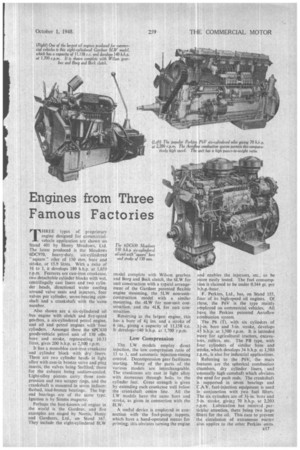Engines from Three Famous Factories
Page 143

If you've noticed an error in this article please click here to report it so we can fix it.
THREE types of proprietary engine designed for commercialvehicle application are shown on Stand 401 by Henry Meadows. Ltd. The latest produced is the Meadows 6DC970. heavy-duty, six-cylindered "
square" oiler of 150 mm. bore and stroke, or 15.9 litres. With a ratio of 16 to 1, it develops 180 b.h.p. at 1,650 r.p.m. Features are cast-iron crankcase. two detachable cylinder blocks with wet, centrifugally cast liners and two cylinder heads, directional water cooling around valve seats and injectors, four valves per 'cylinder, seven-bearing camshaft and a crankshaft with the same number.
Also shown are a six-cylindered oil bus engine with clutch and five-speed gearbox, a six-cylindered petrol engine, and oil and petrol engines with four cylinders. Amongst these the 6PC630 goods-vehicle petrol unit of 130 ntn. bore and stroke, representing 10.33 litres, gives 200 b.h.p. at 2,500 r.p.m.
It has a monobloc cast-iron crankcase and cylinder block with dry liners. There are two cylinder heads in light alloy with cast-in bronze valve and plug inserts, the valves being Stellited, those for the exhaust being sodium-cooled. Light-alloy pistons carry three compression and two scraper rings, and the crankshaft is mounted in seven indiumflashed, lead-bronze bearings. The bigend bearings are of the same type. Ignition is by Simms magneto.
Perhaps the best-known oil engine in the world is the Gardner, and five examples are staged by Norris, Henty and Gardners, Ltd., on Stand 167. They include the eight-cylindered 81W model complete with Wilson gearbox and Borg and Beck clutch, the 61.-W for unit construction with a typical arrangement of the Gardner patented flexible engine mounting, the 5LW non-unitconstruction model with a similar mounting, the 4LW for non-unit construction, and the 4LK for unit construction.
Reverting to the largest engine, this has a bore of 4# ins, and a stroke of 6 ins., giving a capacity of 11,158 c.c. It develops-140 b.h.p. at 1,700 r.p.m.
Low Compression The LW models employ direct injection, the low compression ratio of 13 to 1, and automatic injection-timing control. Decompression gear facilitates starting. Many of the parts of the various models are interchangeable. The crankcases are cast in light alloy with numerous through bolts to the cylinder feet. Great strength is given by extending each crankcase well .below the crankshaft centre line. All the LW modals have the same bore and stroke, as given in connection with the 8LW.
A useful device is employed in connection with the fuel-pump tappets, which have a hand-operated means for priming; this obviates turning the engine
and enables the injectors, etc., to be more easily tested. The fuel consumption is claimed to be under 0.344 pt. per b.h.p.-hour.
F. Perkins, Ltd., has, on Stand 155, four of its high-speed oil engines. Of these, the P6V is the type mainly employed on commercial vehicles. All have the Perkins patented Aeroflow combustion system.
The P6 (T), with six cylinders of 31-in, bore and 5-in, stroke, develops 45 b.h.p. at 1.500 r.p.m. It is intended more for agricultural tractors, excavators, rollers, etc. The PB type, with four cylinders of similar bore and stroke, which develops 34 b.h.p. at 1,500 r.p.m., is also for industrial applications.
Referring to the P6V, the main features are the spherical combustion chambers, dry cylinder liners, and unusually high camshaft which obviates the need for push rods. The crankshaft is supported in seven bearings and C.A.V. fuel-injection equipment is used in conjunction with two fuel filters. The six cylinders are of 31-in, bore and 5-in, stroke, giving 70 b.h.p. at 2,200 r.p.m. Lubrication has received particular attention, there being two large filters for the oil. This care to prevent the circulation of extraneous matter also applies to the other Perkins units.












































































































































































































































